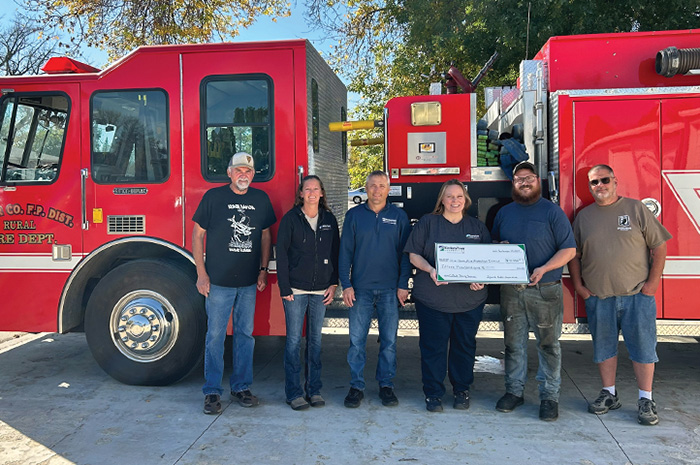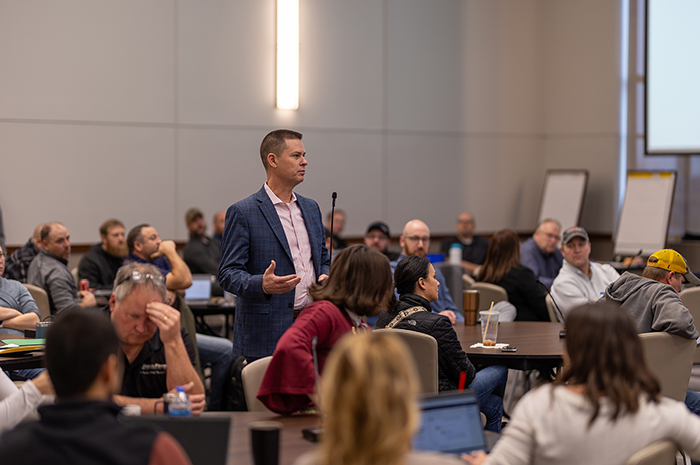Electric bus makes the grade
West Fargo Public Schools has experienced transportation savings and benefits after a year with an electric addition to the fleet.
West Fargo Public Schools (WFPS) bus driver Leo Rognlin arrives at the district’s transportation garage at 6:50 a.m. every work day. His pre-trip routine is always the same – check his bus’s tires, look at the brakes and examine the engine compartment before starting his route.
He’s like a well-oiled machine. His bus, however, is not.
“That’s probably the difference between the electric and the diesel – I don’t have to check oil,” he said.

Rognlin is the lucky driver of WFPS’s all-electric Blue Bird school bus, purchased by the district and community partners like Minnkota Power Cooperative and Cass County Electric Cooperative (CCEC) in 2019. The bus, designated as e16, began its second school cycle of transporting students this September, following a successful “freshman” year.
“Oh, we were very happy,” said Brad Redmond, WFPS transportation director. “We saw significant savings on our energy costs, and it ran really well as far as being able to go out and do the route. “
Even though bus routes were stopped early in the spring when COVID-19 kept students learning at home, a cost comparison of the electric bus to a diesel counterpart (purchased at the same time) showed a total operations and maintenance savings of $3,269.62 over seven months. The diesel bus cost 42 cents a mile to power and drive, whereas the electric bus cost only 14 cents per mile.
Although the upfront cost of an electric bus is higher, Redmond believes the savings could bridge that gap over the lifetime of the bus. He added that once the district has the bus for a few years to confirm the savings and performance hold up, he could see them investing more in electric.

Power perks
The benefits of the electric bus went beyond savings. Rognlin, a new driver for WFPS this year, said he had no problem translating his diesel-bus training to an all-electric rig.
“It operates very similarly to a diesel,” he said. “I really like it. It’s been a great ride and performs well on the highway. I have more than enough acceleration if I have to merge into traffic.”
On top of the speedy acceleration, the electric motor has other benefits. Rognlin doesn’t have to stand in the cold to refuel – he simply pulls into the garage and plugs in. But there’s one perk he appreciates most.
“It’s nice and quiet. I can hear what’s going on with the kids better,” he said. Even though students are more widely spaced this year as a COVID-19 precaution, Rognlin says they can still easily communicate without the obtrusive rumbling of a diesel engine. “I think that it’s a more enjoyable experience for them,” he said.
“The biggest question from them is, ‘Why does this bus have green bumpers?’ You explain to them that this is an all-electric school bus, and they think it’s pretty neat,” Redmond said. “It’s an emerging technology that I think is going to be a part of their future, and they’re one of the first in the state to ever be a part of this.”

Lessons learned
The WFPS transportation department knew the first winter would be a learning experience, for them as well as for the manufacturers – it was the first truly northern climate the technology had faced. A decrease in the bus’s 100-mile range was expected in the coldest months (as is also expected with diesel), and the bus still had plenty of battery power to cover its daily routes.
WFPS worked with Blue Bird and its local distributor, Cummins, to retrofit nylon fittings for coolant that cracked in the temperature drop. They also collaborated on a winter package for the bus that insulates the battery compartment from the cold. A software update was also added, allowing the bus to preheat the cabin and coolant while plugged into the charger.

As Redmond and his team learn more about the bus, school districts from coast to coast have reached out about WFPS’s experience. With the financial support and electrical systems guidance of CCEC, the school district has become a national trailblazer.
“Two of CCEC's core values are innovation and commitment to community,” said Chad Brosseau, CCEC business accounts executive. “With new technology, there are always unknowns and challenges to overcome. By partnering with our member organizations, we can help them take those first steps.”
Whether it’s taking those first steps or driving those first miles, Rognlin is just glad e16 has become a part of his daily routine. “It’s an outstanding bus, in my opinion. Being the new guy, I figured I would just get what I get, but I was fortunate that it was assigned to me,” he said.
Main image: WFPS transportation director Brad Redmond (left) and bus driver Leo Rognlin (right) showcase e16, the district's 100% electric school bus. (Minnkota/Michael Hoeft)
...



